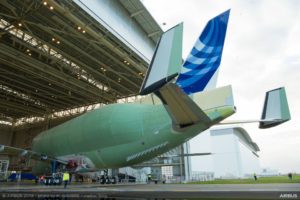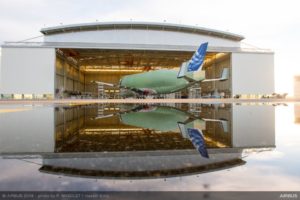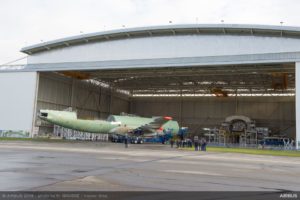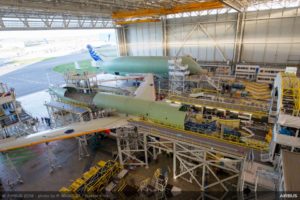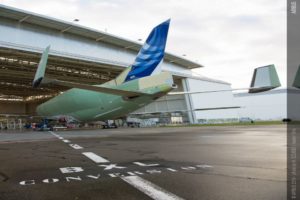Aviation
First BelugaXL transporter rolls out

The first structurally complete airframe for the new BelugaXL rolled out from its assembly hangar in Toulouse, France this month. Once operational, a fleet of these next-generation airlifters will be used to transport completed sections of Airbus aircraft among the company’s European production sites and to its final assembly lines in France, Germany and Spain.
Before that can happen, the aircraft will undergo a months-long battery of tests after installation of its two jet engines, ensuring each of the BelugaXL’s systems function as intended. All the while, said George, “We will perform bench tests in Toulouse and Hamburg, Germany – testing our systems on flight simulators and in laboratories” as well as using hydraulic jacks to simulate flight loads on full-scale copies of specific joints between the new upper bubble and A330’s lower fuselage.
“The data from these tests will be used to clear the aircraft for flight and, later on, to attain type certification,” the official pronouncement of the aircraft’s safety and airworthiness, said George.
As BelugaXL no. 1 begins testing, no. 2 moves to integration
While the first structurally complete BelugaXL moves into its testing phase, the second A330 airframe to be converted into a BelugaXL arrived on schedule in Toulouse to begin its integration process. George noted that with lessons learned from the production of the first transporter, the assembly time for the second is expected to be about two months shorter.
The BelugaXL programme was launched in November 2014 to address Airbus’ increasing transport requirements. At six metres longer, one metre wider and with a payload lifting capacity six tonnes greater than the BelugaST transporter version it is replacing, the BelugaXL will be able to transport both wings of the flagship A350 XWB jetliner at once, instead of the single wing currently accommodated on the BelugaST. All told, five BelugaXLs are scheduled to enter service for Airbus’ airlift needs.

Aviation
Airbus Plans Cockpit Toilet to Make Single-Pilot Operations a Reality

In a bold move aimed at cutting costs, Airbus is exploring the possibility of installing a potty-style toilet right behind the Captain’s seat on its A350 long-haul aircraft. According to the reports from paddleyourownkanoo.com
This proposal is part of the ongoing effort to implement Extended Minimum Crew Operations (eMCO), a concept that could revolutionize the aviation industry by reducing the number of pilots required on ultra-long-haul flights.
Air India Invests in Future Talent: 50,000 Staff to Be Trained at New Facility
Currently, on long flights, two pilots stay in the cockpit while the others rest in a separate compartment. However, under eMCO, one pilot could be alone in the cockpit for up to three hours while the other sleeps. The goal is to reduce crew costs and improve airline efficiency, as fewer pilots would be needed for these flights.
But this proposal has raised concerns from pilot unions, who worry about safety and the challenges of single-pilot operations. To address the issue of bathroom breaks, Airbus suggests installing a radio-equipped toilet in the cockpit, allowing the pilot to use it without leaving their seat.
UAE Visa: New Rules and Regulations – These Items Are Now Prohibited in the UAE
If the pilot needs to use the toilet, the second pilot would have to be woken up, terminating the eMCO process temporarily.
If successful, Airbus plans to begin testing this system on its A350 aircraft as soon as 2027, with single-pilot operations possibly being introduced on freighter Airbus A320s within the next five years.
-

 Aviation2 months ago
Aviation2 months agoMicrosoft Flight Simulator Raises $3 Million to Bring Back the An-225 Mriya
-

 Airlines2 months ago
Airlines2 months agoQatar Citizens Can Travel to the United States Without a Visa
-

 Defence2 months ago
Defence2 months agoWhich Country Has the Largest Fleet of Fighter Aircraft?
-

 Airlines1 week ago
Airlines1 week agoDAMAC Air: Dubai’s New Luxury Airline Offers Free Flights for Registration
-

 Airlines1 week ago
Airlines1 week agoAir India to Launch aircraft maintenance training institute in Bengaluru
-

 Airport2 months ago
Airport2 months agoWestern Sydney Airport Welcomes Its First Plane After 6 Years of construction
-

 Aviation2 months ago
Aviation2 months agoDid you know ? Once Boeing 747 carried 1088 passenger in 1991
-

 Travel1 week ago
Travel1 week agoThis country tops visa rejections in the popular Schengen countries

